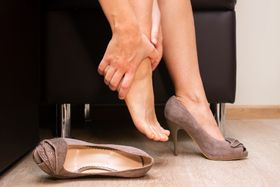Can Flat Feet Cause Back Pain?
Updated December 9, 2024.

The feet connect with the floor and carry the weight of the body as we go about our daily activities. If there is an imbalance stemming from the feet, it can have a negative effect on the rest of the body.
Strong, properly aligned feet serve as a stable base for the body to move off of. Read further to see how flat feet could be causing your back pain and how to relieve this pain using various conservative methods.
What Are Flat Feet?
Flat feet are a common condition associated with a loss of arch height. This can be seen when weight is applied to the foot. This condition is usually seen in childhood where the arches are flat.
As you age, the muscles of the feet strengthen to develop the arch of the foot, ready to take the weight of a growing body. If the muscles and arches don’t develop adequately, the feet remain flat through adolescence and into adulthood.
Flat feet can be caused by obesity, ligament laxity, pregnancy, and hereditary characteristics. Flat feet and the associated symptoms of the condition can be managed through a variety of conservative management strategies, such as exercise, custom orthotics, and massage techniques.
How Do Flat Feet Cause Back Pain?
Back pain is one of the potential dangers of flat feet. A large number of people with flat feet report experiencing lower back pain in comparison to those with a normal or high-arch structure.
The biomechanical misalignment from the overpronation of the feet and ankles increases the stress placed on the ankles, knees, hips, and subsequently the lower back. Flat feet do not absorb the weight of the body effectively as the feet strike the floor, resulting in higher forces being placed on the joints of the legs.
These forces move upwards into the hips and spine, causing pain and potentially other conditions, such as osteoarthritis.
How to Alleviate Back Pain Caused By Flat Feet
Making use of orthotics or appropriate footwear to prevent overpronation of the foot and correct the misalignment in biomechanics that comes along with overpronation can prevent straining the muscles and ligaments of the ankle complex.
The support from the orthotics will further lessen the strain placed on the back and joints of the leg by absorbing some of the pressure placed on the foot. Simple exercises in conjunction with suitable arch support can manage the condition effectively.
Medication for pain management, if necessary, can also be used. Heat can also be applied to the back before exercise or while exercising to relieve symptoms of pain. Back stretches are a great way to relieve back pain while maintaining mobility of the spine. Here are some back stretches for pain relief and to maintain spine mobility:
- Back flexion Lying on your back, bend your knees and hips to bring both legs up to your chest. Hold your legs against your chest for 15–20 seconds while bending your head forward for maximum back stretch. You should experience an elongating sensation throughout the entirety of the back.
- Lower back rotations Lying on your back with your knees bent and feet together, slowly rotate your lower back and lower your legs towards one side. This should create a stretch in the opposite side of the back. Keep your shoulders flat against the surface. Pull your knees to the midline and repeat again. Repeat 15–20 times.
- Gluteal stretch Lying on your back (preferably on a surface where your feet are able to be placed comfortably on the floor), pull one knee up to your chest and hold for 15–20 seconds. You should experience a stretch in your glutes. Repeat on the other leg.
Exercises to strengthen the abdominal muscles, which are associated with a reduced chance of developing lower back pain, can also be done frequently for effective self-management.
Strengthening the muscles making up the foot and lower leg will improve arch development, leading to less pronation in the foot and reduced body misalignment. Here are some exercises that you could try:
- Toe crunches Sitting with your feet facing forward, curl your toes into the floor and back towards your heel, elevating the arch slightly. Hold for 5–10 seconds, then relax. Repetitions of sustained contractions will improve strength greatly over time.
- Heel raises You may prefer to stand in front of a wall for increased balance. Push onto the toes and rise onto the forefoot, contracting the calf muscle. Hold for 3 seconds and relax. Do 8–10 repetitions three times daily.
- Toe exercises With one foot on top of the other, alternate between pushing down your big toe while raising your other toes and lifting your big toe while pushing your other toes down into the floor. Hold for 4–5 seconds, then relax. Repeat on the other foot.








